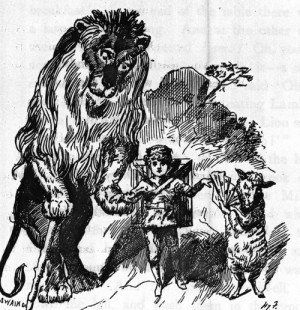 Carroll’s picnic in Sylvie and Bruno Concluded is mean-spirited. Carroll wanted to transcend Alice and get to issues of religion, society, and politics, narrated by the childish fairies Bruno (about 5) and Sylvie (about 9).
Carroll’s picnic in Sylvie and Bruno Concluded is mean-spirited. Carroll wanted to transcend Alice and get to issues of religion, society, and politics, narrated by the childish fairies Bruno (about 5) and Sylvie (about 9).
“Bruno’s Picnic” and “The Little Foxes” are linked stories; for example, they are didactic lessons for children about good behavior and obedience or facing punishment. It’s Victorian and very mean, like Stella Austin’s Stumps, A Story for Children (1873).
The first story begins when Bruno decides to picnic. “So Bruno said to himself, ‘The properest thing to do is to have a Picnic, all by myself, on the top of the hill. And I’ll take some Milk, and some Bread, and some Apples: and first and foremost, I want some Milk!”
He initially wants to be alone but changes his mind when he meets a lion, now a vegetarian, and a lamb and invites them to join him. When the lamb goes to wash in a stream, he meets a fox, who slyly invites him home, obviously intending harm. The innocent lamb is saved when the lion arrives and bites off the fox’s head. According to Bruno, the lamb’s lesson is to beware of foxes. When Bruno rescues the fox’s kits, he puts them in his picnic hamper and instructs them: “Now, little Foxes, you’re going to have your first lesson in being good. I’m going to put you in the hamper, along with the Apples and the Bread: and you’re not to eat the Apples: and you’re not to eat the Bread: and you’re not to eat anything—till we get to my house: and then you’ll have your supper.”
Of course, the foxes eat Bread and apples. Worse, when Bruno opens the hamper, there is one less fox. The oldest fox has not only eaten the others, and he is so greedy that he eats himself, leaving only his mouth. Unperturbed, Bruno empties the mouth and restores the three little foxes, chastised for wickedness. He takes them home and refuses to feed them until they conform. Now, little Foxes, you’ve begun very wickedly—and you’ll have to be punished. First, you’ll go up to the nursery, and wash your faces, and put on clean pinafores. Then you’ll hear the bell ring for supper. Then you’ll come down: and you won’t have any supper: but you’ll have a good whipping! The foxes do learn their lesson, but at a cost Carroll could never fathom.
The two volumes of Sylvie and Bruno (1889 and 1893) are seldom read. They are ably illustrated by Harry Furniss, who thought that Carroll was an egotist and hypocrite and that the novels were “ill-conceived books.” Carroll never knew that Furniss’s models for S & B were his children.
The reference to the “little foxes” may be an allusion to the Song of Solomon 2:15: “Catch the foxes for us, The little foxes that are ruining the vineyards, While our vineyards are in blossom.” ( New American Standard Version, 1995). Not sure there’s a point here that is immediately understandable. Lillian Hellman’s The Little Foxes (1939) is unrelated.
Featured Image: Harry Furniss. “So they set off.” (1893)
See Carroll, Lewis. “Bruno’s Picnic and The Little Foxes.” In Sylvie and Bruno Concluded, edited by Illustrated by Harry Furniss. London: Macmillan & Co., 1893. http://www.hoboes.com/FireBlade/Fiction/Carroll/Sylvie/Concluded/Chapter14/; http://www.hoboes.com/FireBlade/Fiction/Carroll/Sylvie/Concluded/Chapter15/; Harry Furniss. The Confessions of a Caricaturist. 2 vols. New York: Harper and Brothers, 1902; Gubar, Marah. “Lewis in Wonderland: The Looking-Glass World of Sylvie and Bruno.” Texas Studies in Literature and Language 48, no. 4 (2006): 372-394.

